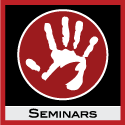

Live: PrairieFire @ Photoshop World — Day 2
Even though my family genealogy charts cast great doubt on the possibility, I’ve always chosen to believe that I am, at least in part, Native American. And, today, at Photoshop World, that belief was strengthened when my friend, Joe McNally, called me from the audience to “model” in his class. I hate to be in front of the camera. Hate it. Have all my life. In fact, when I was a very young boy, during a cross country trip, my family stopped at the Grand Canyon. For a fee, tourists were able to have their pictures taken with Native Americans in tribal garb. My parents paid — and I ran away.
If I could have run away from Joe, I would have.
Most people would pay to have Joe photograph them. Am I some form of ingrate? No, I think it is cultural. As an academic I taught Native American law. I wrote about Native American legal history. I studied the culture. Strongly admired and identified with it. At one point in my studies, I told some elders about my having run away from the camera. They understood. They told me that in some parts of the culture, it was/is believed that a camera captures a part of one’s soul. Those of us with that belief choose to avoid being in front of cameras. But, this morning, I couldn’t.
The Upside: Some Quick Lessons from Joe McNally
Trauma or not, I learned a lot from Joe, this morning. I always learn from Joe. I’ve read his books, bought his DVD’s, attended his seminars, seen him at conferences, watched everything he has on Kelby Training, and written a lot about him on this site. No one has had a greater influence on the way I approach the use of “small” lights than Joe. I admire him as a teacher and I admire him as a man. If you’ve not seen any of Joe’s materials or taken his classes, you should; in fact, if you’re in or around Houston, he’ll be in town on September 18-19 — check out the calendar on my site for details. From Joe, we get inspiration and learn some important technical stuff. Here are some quick hitters from this morning:
1. When explaining why it is often better to use additive light rather than simply boosting ISO (which on most modern cameras allows us to shoot with very little ambient light), Joe responded, “ISO addresses the quantity of the light, not the quality of the light.”
Yes, we can get an image by simply boosting the ISO. But, by adding light we can create direction and/or control the color and nature of the light. Direction gives depth and dimension. Important lesson number one from the morning.
2. When an off camera light did not fire, “If something goes wrong, shoot it again. It’s often pilot error.” Or, it’s some random quirk. From Joe, I’ve learned to stay calm. To try another time, and if there’s still a problem to run through the variables. In my experience, the most likely cause of the failure of a light to go off when shooting TTL is that it’s not in the line of sight of the command unit. In Joe’s case this morning, one of the lights was not set in TTL mode. There’s always an explanation — we simply need to stay calm and find it — as Joe did in front of a class of a few hundred people.
3. Many of us have had clients who tell us “I’m busy, you have 5 minutes. Get it quickly.” We all panic. And, so does Joe. Then we get the shot. I love Joe’s internal response.
“I’m on a daily rate. I only have to spend 5 minutes with this guy? Hmm. My rate just went up quite a bit.” But, actually, because of his strong personal skills, and the fact that he is constantly engaging his subjects, I’ll bet Joe is rarely held to that 5 minute time limit. Joe lives up to his teachings — he does his very bet to make his subjects enjoy the session. He almost got me to like it. Almost.
4. And, finally, some very practical tips:
a. Joe often shoots at ISO 400 and around f5.6. Why? Because, with the increased ISO and lower f/stop, the speedlights have less to do — the situation demands less power. They will recycle faster and run cooler;
b. A camera in Manual Mode will ignore changes in exposure compensation — but the speedlights will recognize the changes. In iTTL, exposure compensation ALWAYS affects the flash setting. In the Priority modes, exposure compensation affects both the camera and the flash.
a. Crossing lights can drive iTTL nuts. If you’re getting wacky results, and you have lights that are throwing crossing beams, the system may be going wacky trying to interpret and control them. Some times, you have to revert to Manual mode. It’s not that hard.
d. Both Nikon and Canon claim sync speeds of 1/250 BUT that speed only applies to their own flash units. So, if you are trying to sync to studio lights, Quadras, or a combination of different lights, you will have to shoot at 1/200. I really didn’t know this. I’ve never run into the problem because I shoot at much lower speeds in the studio or when using my Profoto 600BR. But, it’s a very good thing to know.
OK. Even though I had to model, I’m glad I attended both of Joe’s sessions. I learned a lot.
A Few Other Practical Tips From the Day
1. From Alan Hess‘ class on Concert and Event Photography — perhaps, the most practical tip of the week. Always carry extra ear plugs. Offer them to the security guards — the guys who determine how long you’ll be able to shoot and where you can go; this simple gesture often builds trust, friendship and respect — all of which can lead to your being allowed to stay a bit longer or stray a bit outside the boundaries. Plus, you’ll be doing them a public service by helping save their hearing.
2. From Calvin Hollywood — perhaps, the most exciting speaker I’ve seen this week. Calvin is so out-of-the box in his approach to all things Photoshop that I’ve seen many of the most respected PS teachers sitting in his audiences with their mouths open. This guys stuff rocks.
One tip I’m going to try as soon as I get home: Some times we shoot someone knowing that we are going to put their image over a new and different background. Most of us approach the task by using some sort of selection tool to lift them off the original background.
Calvin demonstrated an easier approach. Shoot the subject in front of a neutral gray background. To substitute backgrounds, put the new background on a layer above the original. Set the blending mode to Soft Light. The gray will disappear giving way to the new background. Why? Because the Soft Light blend mode replaces the neutral gray in an image with the new layer. Because there may be something close to neutral gray on the subject, we may have to add a white mask and paint over the subject in black, blocking the upper layer’s impact on the subject.
I’ve got to try this. I deliberately painted my studio walls neutral gray because I didn’t want them throwing any color casts. And, now, I find out that, out of pure luck, I may be able to really make my compositing easier by removing the need to extract subjects from the original photos. I’ll try and demo this, soon.
–30–
(Copyright: PrairieFire Productions/Stephen J. Herzberg — 2010)








Leave a Reply